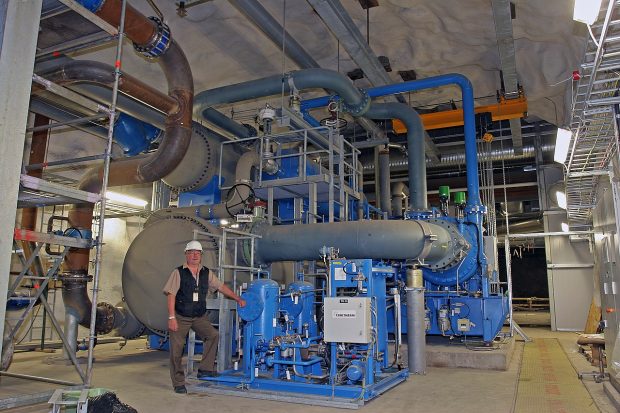
Heating and cooling plant (Wikimedia)
On 20 March 2025, Berlin marked a major milestone in its energy transition. Blockheizkraftwerks- Träger- und Betreibergesellschaft mbH (BTB) – one of the city’s district heating suppliers – officially burned coal for the last time at its Schöneweide district heating plant. This decisive step paves the way for a cleaner, smarter, and more collaborative energy future for the German capital – and beyond
BTB – part of the E.ON group and one of Berlin’s three district heating operators – provides heat to 80,000 households, businesses, and public buildings, generating 682 gigawatt-hours (GWh) of heat and 22 GWh of electricity annually. Encouragingly, despite their ability to grow by 10 MW every year, BTB is now reducing emissions, thanks in part to its long-term strategy to become fully decarbonised by 2045.
With the end of coal at Schöneweide, BTB is embracing a more diverse and sustainable set of heat sources. One particularly exciting development is the integration of a heat pump that draws thermal energy from the nearby River Spree.
Beyond that, BTB is actively exploring innovations such as heat storage, grid optimisation, and advanced heat forecasting tools to ensure resilience and efficiency of its new system. In addition, the company would like to harness and integrate heat from wastewater treatment and data centres to harness the unused heat produced from their respective processes.
The district heating system of Berlin is one of the largest in Europe and is very similar to heat networks in central and eastern Europe. Like its counterparts in central and eastern Europe, it was a result of socialist planning during the post-war reconstruction period and was traditionally based on coal. Connected to over one million homes, its path to decarbonisation will be technically and economically challenging.
Public funding as a catalyst for change
Thankfully, financial support from the German state is making much of this transformation possible. Since September 2022, the government has launched the Bundesförderung für effiziente Wärmenetze (BEW) programme which is a financial source for district heating companies to decarbonise their systems, via renewables and heat recovery. This programme is worth EUR 3 billion until 2030, making it one of the largest district heating decarbonisation financial schemes of its kind in Europe, and can also be an example for countries in central and eastern Europe looking to develop district heating decarbonisation financing schemes.
But progress is far from frictionless. Like many other district heating providers, BTB faces a systemic issue: the lack of coordinated, city-level planning. For instance, infrastructure like wastewater treatment facilities – often a goldmine for heat recovery – are rarely designed with district heating in mind. Without integrated, cross-sector planning, valuable opportunities for sustainable heat generation are being lost.
Another, more delicate challenge is Germany’s cultural resistance to digitalisation – an issue that’s often overlooked in public discourse. Tools like smart metering and digital energy management are essential for a decarbonised heat network. Yet, due to strict data protection norms and public scepticism around digital tools, implementing these technologies at scale remains a significant hurdle.
The heat transition isn’t just an engineering challenge – it’s a social one, too. If we want to decarbonise effectively, we need the public on board. That means making these conversations accessible—not just for engineers and plant operators, but for everyday citizens as well. Bridging the gap between technical innovation and public understanding is the key to decarbonisation success.
Beyond technology
BTB’s move away from coal is a powerful symbol of what’s possible when policy, innovation, and ambition align. It also offers key lessons for municipalities across Europe, especially in central and eastern Europe.
But Berlin’s experience also highlights the complex terrain ahead – from digital transformation and infrastructure integration to public engagement. The heat transition isn’t just about replacing boilers and pipes – it’s about reimagining how cities generate, distribute, and value heat.
To succeed, the transition must be a shared effort across sectors and city agencies – but also one that includes the people who will ultimately live with its outcomes. Berlin’s farewell to coal is just one chapter, but a hopeful one, in the broader story of Europe’s heat transition.
Morgan Henley
Originally published
by CEE Bankwatch Network
May 26, 2025





